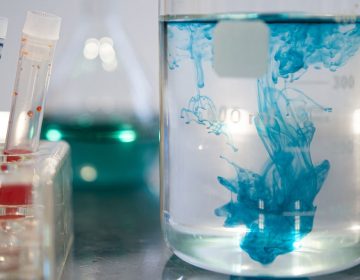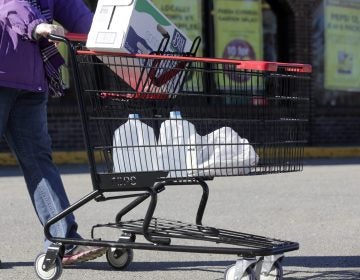PFAS control advocates highlight FDA data showing chemicals in food
The FDA tested 91 meat, dairy, grain, and produce samples, and found PFAS in 10 of them.

(Chocolate cake image courtesy of Shutterstock.com)
This article originally appeared on NJ Spotlight.
—
New Jersey campaigners for tighter curbs on toxic PFAS chemicals got a boost from new federal data showing the chemicals are present in foods such as salmon, pineapple, kale, and even chocolate cake.
The U.S. Food and Drug Administration found the chemicals in 10 kinds of meat and fish and several other foods tested in eight states in October 2017, according to the data that was presented to a recent environmental conference but has yet to be officially published by the agency.
The states, all in the FDA’s mid-Atlantic region, did not include New Jersey, but the widely available nature of the foods suggests that New Jersey and other states are likely to be affected.
The meat and fish samples were found to contain varying levels of PFOS (perfluorooctyl sulfonate), a type of PFAS (per- and polyfluoroalkyl substances) that is linked to cancer and other illnesses, and whose presence in drinking water is in the process of being regulated by New Jersey to one of the nation’s strictest standards.
FDA tests reveal presence of PFAS
The FDA tested 91 meat, dairy, grain, and produce samples, and found PFAS in 10 of them. In meat and fish, contamination with PFOS ranged from 134 to 865 parts per trillion (ppt). For PFOS in drinking water, New Jersey has adopted a standard of 13 ppt, and the U.S. Environmental Protection Agency recommends an upper health limit of 70 ppt — a level advocates say is too high to protect public health.
In chocolate cake with icing, the FDA found PFPeA (perfluoropentanoic acid), another kind of PFAS chemical, at 17,640 ppt or 252 times the EPA’s drinking-water standard.
In June 2018, the agency also tested for 16 kinds of PFAS in leafy greens such as collards, kale, and cabbage from farmers markets along a river near an unidentified PFAS production plant in the eastern U.S. It found the highest chemical concentrations in vegetables grown within 10 miles downstream of the plant. The vegetables also contained a substance made by the GenX technology which has been adopted as a replacement for PFOA because of health concerns, but which some scientists say may be just as toxic.
The PFAS poster
The data showing PFAS in food was presented recently in a poster at an environmental conference in Finland. The poster was photographed by an environmental activist and then sent to the Environmental Working Group, a nonprofit that advocates for tighter controls on the chemicals.
Peter Cassell, a spokesman for the FDA, confirmed the authenticity of the poster but did not respond to questions on exactly where the tests took place, or why the data were not published until some 18 months after the samples were taken.
The FDA said none of the samples is likely to represent a threat to human health.
But advocates for tighter restrictions say that even low levels of PFAS can cause illnesses, including some cancers, thyroid disease, and high cholesterol.
“The results from FDA clearly indicate that some food products are much more contaminated than others,” said David Andrews, a senior scientist with the Environmental Working Group, during a conference call for reporters.
Although most regulation and legislation on PFAS has focused on drinking water, the persistence of the chemicals in the environment suggests that they are also contaminating food, Andrews said. He called for more testing to understand the extent of PFAS contamination of food and identify its sources.
New Jersey’s high rate of contamination
In New Jersey, which has some of the nation’s highest PFAS contamination, the FDA report is likely to build support for measures to protect public health.
State Sen. Bob Smith, who chairs the Environment and Energy Committee, said the data underscores the importance of Senate Bill 2879, which would require the Department of Environmental Protection to study and if necessary regulate any food packaging containing the chemicals. The committee is due to consider the bill on June 17.
“We’re already on the issue,” Smith said. “The Legislature can’t set standards because we are not the experts but we can direct the DEP to look into it.”
PFAS chemicals are most likely to get into food though the contamination of soil and water, the FDA said. Typically, they will be found near a source like a factory or a military base where the chemicals have been used in firefighting foam.
Food can also be contaminated through a limited number of “food contact substances” such as cookware and packaging, the agency said.
PFAS in sewage sludge
Another probable contamination source is sewage sludge that typically gets spread as fertilizer on farm fields without being tested for PFAS content, said Colin O’Neil, legislative director for the EWG. He said the EPA does not require testing of sludge although one state, Maine, now does. About half of the 7 million tons of sewage sludge produced by U.S. water treatment plants every year gets pumped onto fields, he said.
The EPA, which says it intends to begin regulating two PFAS chemicals — PFOA (perfluorooctanoic acid) and PFOS — this year, did not respond to a request for comment.
Although the PFAS levels in food and water are not directly comparable, the new FDA data shows the need for comprehensive testing on the whole class of chemicals, said Jamie DeWitt, a professor of pharmacology at East Carolina University, during a conference call with reporters. She called the report “another blow” for people who live near sources of PFAS contamination.
Scientists say the chemicals, once used in consumer products like nonstick cookware and flame-retardant fabrics, are widespread in the environment because they don’t break down even after they are no longer made or used to manufacture other products.
The FDA said it authorizes the use of PFAS chemicals in some food packaging such as oil and water-resistant coatings on paper products, which have the potential to transfer to food. The agency said it reviews new data on the safety of food packaging as it becomes available.
“While FDA testing to date has shown that very few foods contain detectable levels of PFAS, due to health concerns related to these chemicals, the FDA is working to better understand the potential dietary exposure to PFAS,” the agency said.
WHYY is your source for fact-based, in-depth journalism and information. As a nonprofit organization, we rely on financial support from readers like you. Please give today.




